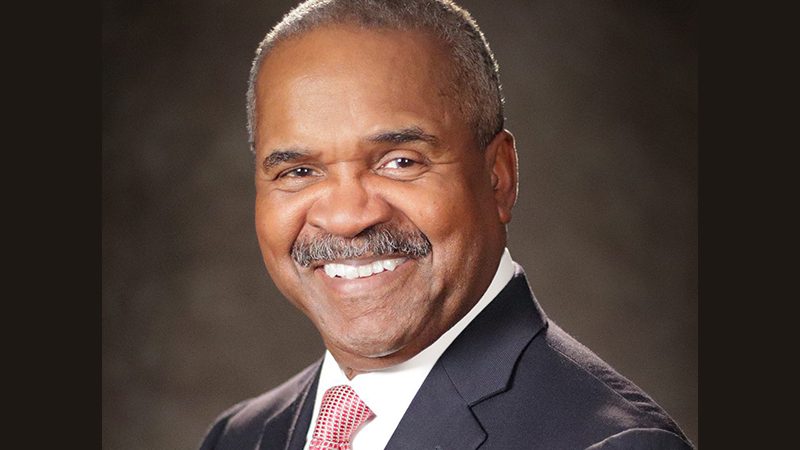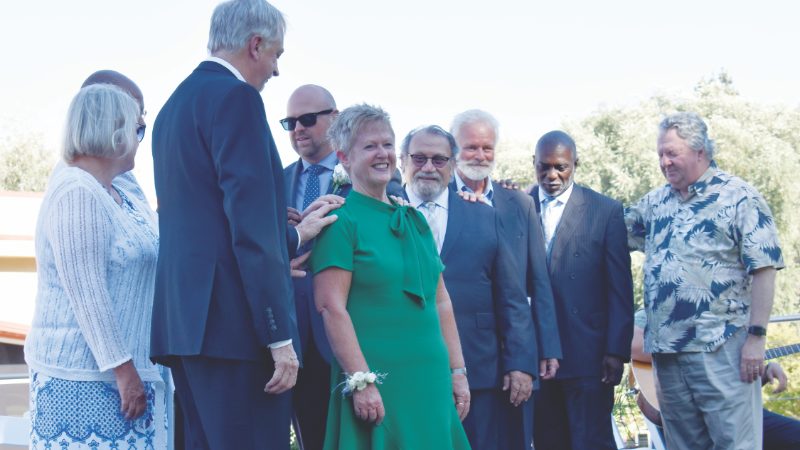In 1847, Samuel Rhodes—a deeply committed believer in the teachings of William Miller, the Baptist preacher whose interpretation of biblical prophecy sparked the Advent movement—hit rock bottom. Penniless after investing all his financial resources in the movement, his spirit broken by the verbal abuse heaped on him by many of his former friends, and believing that God had forsaken him, Rhodes, like Elijah, fled to a secluded place. For three years he hid himself amidst the wilderness of the Adirondacks of northern New York. Miles from anyone, he lived the life of a hermit. But Samuel Rhodes had a friend in a man named Hiram Edson.
Knowing that it was their shared experience and struggle that had left Rhodes broken and discouraged, Edson went looking for Samuel Rhodes.
Edson had been instrumental in helping the Millerite believers make some sense of what had—and had not—happened on October 22, 1844, when Jesus did not return as they had hoped, believed, and taught. Knowing that it was their shared experience and struggle that had left Rhodes broken and discouraged, Edson went looking for Samuel Rhodes. Three times Edson ventured into the wilds to try to find Rhodes and persuade him to return to the fellowship of the Advent believers. Three time he failed to find him, but he was undaunted in his quest.
And then, one fateful night, Edson dreamed of entering a room in which six discouraged people were praying, and one of them said to him, “Oh! Brother Edson, I am in the dark!”1 His thoughts went to Samuel Rhodes.
At a meeting just eight days after his dream, when fellow Millerite Richard Ralph mentioned the challenges of trying to find Rhodes, Edson suddenly felt that perhaps his dream was a calling.
He sought Ellen White’s advice, and she expressed skepticism about trying to find a man who did not want to be found. But during a subsequent prayer session seeking God’s guidance, Edson reported that the Holy Spirit “settled upon us so that the place was awful and glorious.”2 This is where this story takes an unexpected turn.
During the meeting, Richard Ralph began speaking in an unknown tongue. Providing the interpretation for those kneeling in prayer, he said that God wanted Edson and him to search for Rhodes.

The following morning, after receiving a vision affirming this perception, Mrs. White granted her approval for the mission to go find Samuel Rhodes and bring him back to the little flock, instructing them to tell Rhodes that God loved him, that there was “hope and mercy for him,”3 and that angels would protect him if he returned with Edson and Ralph.
Off they went. And then, after journeying 14 miles into the forest, they found Rhodes, looking every bit the hermit.
Rhodes responded to their arrival and entreaties to return by telling them of a dream that he himself had experienced—a dream of two men who were seeking him. Brothers Edson and Ralph shared the message they had received from Ellen White, and Richard Ralph was again moved to speak in an unknown tongue—behavior that Rhodes took as a sign of God’s love and approval.
And with that, Samuel Rhodes came home. The cloud of despondency under which he had lived since 1844 cleared, and Edson recorded the reaction of the little flock in a letter sent to Present Truth: “They were all rejoiced to see Bro. Rhodes. Tears of joy and tenderness flowed freely as they greeted each other. We had a sweet, heavenly sitting together during the meeting, and Bro. Rhodes’ faith and hope are fast increasing. He stands firm in all the present truth; and we heartily bid him God speed, as he goes to search out and feed the precious, scattered flock of Jesus.”4
This story is included in Brian Strayer’s’ 2023 biography of Hiram Edson (available on Amazon from Oak & Acorn Publishing). I am inspired by the way our spiritual forebears muddled along through their theological discoveries and personal faith. I am inspired by their zeal and determination fueled by the hard-won convictions born from dedicated exploration of the Scriptures, thoughtful questions and discussion, and heartfelt devotion. How heartening it must have been to hear Ellen White’s assurance that there was “hope and mercy” for them. These are surely words that would be as powerful as that other assuring statement from her that has become so familiar to us: “We have nothing to fear for the future, except as we shall forget the way the Lord has led us, and his teaching in our past history” (Ellen G. White, Testimonies for the Church, vol. 9, p. 10).
But Professor Strayer’s book wasn’t published generations ago and wasn’t included in reading lists or available in Adventist libraries—nor have any biographies of Hiram Edson been published until now to feed the precious, scattered flock of Jesus.
Which brings me to the question of fundamentalism.
In a TEDTalk in 2009, Nigerian author Chimamanda Adichie spoke passionately and persuasively about “The Danger of the Single Story.” In it she cautioned against the simplified narratives that avoid troubling complexity and suppress inconvenient details. “The single story creates stereotypes,” asserted Adichie, “and the problem with stereotypes is not that they aren’t true, but they are incomplete. They make one story become the only story.”5
The rise of the single story is the roadway to fundamentalism. Both fundamentalism and the adoption of a single narrative are reductionist. Complex events and ideas are oversimplified. Alternative viewpoints are suppressed. Inquiry is discouraged. Stereotypes flourish. Assumptions remain unchallenged.
One hundred and seventy-two years ago this summer, just four years after the epic rescue of Samuel Rhodes, James White responded in the pages of the Advent Review and Sabbath Herald to a letter from a group of Seventh Day Baptists who wrote asking who Adventists were. His words embraced a wide horizon—a generous orthodoxy of fellowship and inquiry.
As a people we are brought together from divisions of the Advent body [the Millerites], and from the various denominations, holding different views on some subjects; yet, thank Heaven, the Sabbath is a mighty platform on which we can all stand united. And while standing here, with the aid of no other creed than the Word of God, and bound together by the bonds of love—love for the truth, love for each other, and love for a perishing world—“which is stronger than death,” all party feelings are lost.”6
These are powerful words that stand in stark contrast to the narrowed vision of a single story or fundamentalism.
In the spirit of Hiram Edson, Richard Ralph, James White, and Ellen White, let us set about to rescue Samuel Rhodes—who shall not be forgotten. We will need to journey out beyond the borders of our settled history into the wild forests and reclaim that which once was lost. We will need the brightest lights to push back the darkness, not a dimmed and dumbed down low-voltage glow incapable of being focused to illuminate or start a fire. Our faces should shine with the vitality and confidence of stories and scholarship and provocative preaching, burning brightly.
_____________________________
Ray Tetz is the director of communication and community engagement for the Pacific Union Conference and the publisher of the Pacific Union Recorder.
1 Hiram Edson, Nov. 26, 1849, Letter to Present Truth (Dec. 1849), p. 36. The quotes and footnotes from the Samuel Rhodes story are sourced from Brian E. Strayer, Hiram Edson: The Man and the Myth (Thousand Oaks, CA: Oak & Acorn Publishing, 2023), pp. 104-109.
2 D.E. Robinson, “The Gift of Tongues in Early Advent History,” (Center for Adventist Research, James White Library, Andrews University, Berrien Springs MI, n.d.), p. 2.
3 Ellen White, “Beloved Brethren, scattered abroad,” Present Truth, Dec. 1849, p. 35.
4 Edson, Letter to Present Truth.
5 Chimamanda Ngozi Adichie, “The Danger of a Single Story,” TEDGlobal (July 2009), https://www.ted.com/talks/chimamanda_ngozi_adichie_the_danger_of_a_single_story.
6 James White, “Reply,” Review and Herald 4, no. 7 (Aug. 11, 1853), p. 52; emphasis added.
La última palabra: Rescate de Samuel Rhodes
Por Ray Tetz
En 1847, Samuel Rhodes, un creyente profundamente comprometido en las enseñanzas de William Miller, el predicador bautista cuya interpretación de la profecía bíblica desencadenó el movimiento Adventista, tocó fondo. Sin un centavo después de invertir todos sus recursos financieros en el movimiento, con el espíritu quebrantado por el abuso verbal acumulado sobre él por muchos de sus antiguos amigos, y creyendo que Dios lo había abandonado, Rhodes, al igual que Elías, huyó a un lugar apartado. Durante tres años se escondió en medio de los bosques de los Adirondacks del norte de Nueva York. A kilómetros de cualquiera, vivía la vida de un ermitaño. Pero Samuel Rhodes tenía un amigo, un hombre llamado Hiram Edson.
Sabiendo que era su experiencia y lucha compartidas lo que había dejado a Rhodes destrozado y desanimado, Edson fue a buscar a Samuel Rhodes.
Edson había sido fundamental para ayudar a los creyentes milleritas a dar algún sentido a lo que había sucedido y lo que no había sucedido el 22 de octubre de 1844, cuando Jesús no regresó como habían esperado, creído y enseñado. Sabiendo que era su experiencia y lucha compartidas lo que había dejado a Rhodes destrozado y desanimado, Edson fue a buscar a Samuel Rhodes. Tres veces Edson se aventuró en los bosques para tratar de encontrar a Rhodes y persuadirlo de que regresara a la comunidad de creyentes adventistas. Tres veces no lo encontró, pero no se desanimó en su búsqueda.
Entonces, una noche fatídica, Edson soñó que entraba en una habitación en la que seis personas desanimadas estaban orando, y una de ellas le dijo: «¡Oh! ¡Hermano Edson, estoy en la oscuridad!»1 Sus pensamientos se dirigieron a Samuel Rhodes.
En una reunión solo ocho días después de su sueño cuando Richard Ralph, un compañero millerita, mencionó los desafíos de tratar de encontrar a Rhodes, Edson de repente sintió que tal vez su sueño era un llamado.
Buscó el consejo de Ellen White y ella expresó escepticismo acerca de tratar de encontrar a un hombre que no quería ser encontrado. Pero durante una sesión de oración posterior en busca de la dirección de Dios, Edson informó que el Espíritu Santo «se posó sobre nosotros de tal manera que el lugar era asombroso y glorioso».2 Aquí es donde esta historia da un giro inesperado.
Durante la reunión Richard Ralph comenzó a hablar en una lengua desconocida. Al proporcionar la interpretación para los que estaban arrodillados en oración, dijo que Dios quería que Edson y él buscaran a Rhodes.

A la mañana siguiente, después de recibir una visión que afirmaba esa percepción, la Sra. White concedió su aprobación para la misión de ir a buscar a Samuel Rhodes y traerlo de vuelta al pequeño rebaño, instruyéndoles que le dijeran a Rhodes que Dios lo amaba, que había «esperanza y misericordia para él».3 y que los ángeles lo protegerían si regresaba con Edson y Ralph.
Y se fueron. Y luego, después de viajar 14 millas en el bosque, encontraron a Rhodes, con aspecto de ermitaño.
Rhodes respondió a su llegada y a sus súplicas para que regresaran contándoles un sueño que él mismo había experimentado, un sueño de dos hombres que lo buscaban. Los hermanos Edson y Ralph compartieron el mensaje que habían recibido de Ellen White, y Richard Ralph volvió a sentirse movido a hablar en una lengua desconocida, comportamiento que Rhodes interpretó como una señal del amor y la aprobación de Dios.
Y con eso, Samuel Rhodes volvió a casa. La nube de desaliento bajo la que había vivido desde 1844 se disipó, y Edson registró la reacción del pequeño rebaño en una carta enviada a Present Truth: «Todos se alegraron de ver al Hno. Rhodes. Lágrimas de alegría y ternura fluyeron libremente mientras se saludaban. Tuvimos un dulce y celestial convivio durante la reunión, y la fe y la esperanza del Hno. Rhodes están aumentando rápidamente. Él se mantiene firme en toda la verdad presente; y le rogamos de todo corazón que Dios le acompañe, mientras va a buscar y alimentar al precioso y disperso rebaño de Jesús».4
Esta historia está incluida en la biografía de Hiram Edson de 2023 por Brian Strayer (disponible en Amazon). Me inspira la forma como nuestros antepasados espirituales se las arreglaron a través de sus descubrimientos teológicos y su fe personal. Me siento inspirado por su celo y determinación, alimentados por las convicciones duramente ganadas que nacen de la exploración dedicada de las Escrituras, preguntas y discusiones reflexivas, y devoción sincera. Cuán alentador debe haber sido escuchar la seguridad de Ellen White de que había «esperanza y misericordia» para ellos. Esas fueron sin duda palabras que serían tan poderosas como esa otra declaración tranquilizadora de ella que se ha vuelto tan familiar para nosotros: «No tenemos nada que temer para el futuro, excepto que olvidemos el camino que el Señor nos ha guiado, y su enseñanza en nuestra historia pasada» (Ellen G. White, Testimonies for the Church, vol. 9, pág. 10).
Pero el libro del profesor Strayer no se publicó hace generaciones y no se incluyó en las listas de lectura ni estuvo disponible en las bibliotecas adventistas, ni se ha publicado ninguna biografía de Hiram Edson hasta ahora para alimentar al precioso y disperso rebaño de Jesús.
Lo que me lleva a la cuestión del fundamentalismo.
En una charla TEDTalk en 2009, la autora nigeriana Chimamanda Adichie habló apasionada y persuasivamente sobre «El peligro de la historia única». En su charla advertía contra las narrativas simplificadas que evitan la complejidad problemática y suprimen los detalles inconvenientes. «La historia única crea estereotipos», afirmó Adichie, «y el problema con los estereotipos no es que no sean ciertos, sino que son incompletos. Hacen que una historia se convierta en la única historia».5
El auge de la historia única es el camino hacia el fundamentalismo. Tanto el fundamentalismo como la adopción de una sola narrativa son reduccionistas. Los eventos e ideas complejos se simplifican demasiado. Se suprimen los puntos de vista alternativos. Se desaconseja la indagación. Los estereotipos florecen. Los supuestos siguen sin ser cuestionados.
Este verano se cumplen ciento setenta y dos años, justo cuatro años después del épico rescate de Samuel Rhodes, James White respondió en las páginas de la Advent Review and Sabbath Heralda una carta de un grupo de Bautistas del Séptimo Día que escribieron preguntando quiénes eran los adventistas. Sus palabras abarcaban un amplio horizonte, una generosa ortodoxia de compañerismo e indagación.
Como pueblo, nos reunimos a partir de las divisiones del cuerpo adventista [los milleritas], y de las diversas denominaciones, que tienen diferentes puntos de vista sobre algunos temas; sin embargo, gracias al Cielo, el sábado es una plataforma poderosa en la que todos podemos estar unidos. Y mientras estamos aquí, sin la ayuda de otro credo que la Palabra de Dios, y unidos por los lazos del amor —el amor a la verdad, el amor mutuo y el amor a un mundo que perece— «que es más fuerte que la muerte», se pierden todos los sentimientos partidarios».6
Esas son palabras impactantes que contrastan con la visión estrecha de una sola historia o fundamentalismo.
En el espíritu de Hiram Edson, Richard Ralph, James White y Ellen White, pongámonos en Marzoa para rescatar a Samuel Rhodes, quien no será olvidado. Tendremos que ir más allá de las fronteras de nuestra historia sedentaria hacia los bosques y reclamar lo que una vez se perdió. Necesitaremos las luces más brillantes para hacer retroceder la oscuridad, no un resplandor de bajo voltaje atenuado y embrutecido incapaz de enfocarse para iluminar o iniciar un incendio. Nuestros rostros deben brillar con la vitalidad y la confianza de las historias, la erudición y la predicación provocadora, ardiendo intensamente.
_____________________________
Ray Tetz es el director de comunicación y participación comunitaria de la Conferencia de la Unión del Pacífico y editor del Pacific Union Recorder.
1 Hiram Edson, Nov. 26, 1849, carta a Present Truth (Dec. 1849), p. 36. Las citas y pies de página acerca del rescate de Samuel Rhodes son de Brian E. Strayer, Hiram Edson: The Man and the Myth (Thousand Oaks, CA: Oak & Acorn Publishing, 2023), pp. 104-109.
2 D.E. Robinson, «The Gift of Tongues in Early Advent History,» (Center for Adventist Research, James White Library, Andrews University, Berrien Springs MI, n.d.), p. 2.
3 Ellen White, «Beloved Brethren, scattered abroad,» Present Truth, Dec. 1849, p. 35.
4 Edson, Letter to Present Truth.
5 Chimamanda Ngozi Adichie, «The Danger of a Single Story,» TEDGlobal (July 2009), https://www.ted.com/talks/chimamanda_ngozi_adichie_the_danger_of_a_single_story.
6 James White, «Reply,» Review and Herald 4, no. 7 (Aug. 11, 1853), p. 52; énfasis añadido.






